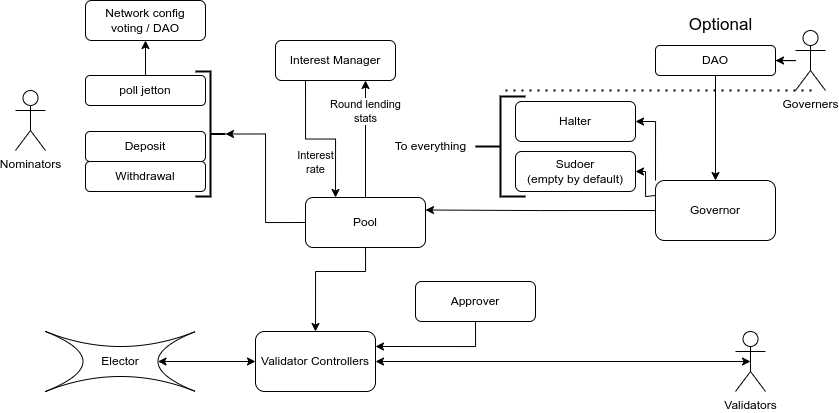Introduction
The Liquid Staking (LSt) protocol serves as a groundbreaking innovation designed to bridge TON holders with node operators, facilitating seamless participation in TON Blockchain validation via asset pooling. This protocol not only democratizes the staking process but also integrates seamlessly with DeFi protocols, offering TON holders, referred to as Nominators, an opportunity to earn validation rewards through Pool Jettons. This document provides an in-depth overview of the LSt protocol, its technical components, and operational guidelines for both nominators and node operators.
Protocol Overview
The LSt protocol introduces a dynamic ecosystem where nominators can lend their TON assets to a pool, receiving Pool Jettons in return. These Jettons, representing a share of the pool, appreciate in value by accruing validation rewards, thereby offering a compelling incentive for TON holders. Node operators, on the other hand, utilize these pooled funds as validation stakes, sharing the accrued rewards with the pool.
| Component | Functionality |
|---|---|
| Nominators | TON holders who lend their assets to the pool in exchange for Pool Jettons. |
| Node Operators | Participants who utilize pooled funds for blockchain validation, sharing rewards with the pool. |
| Pool Jettons | Tokens representing a share in the pool, which can be utilized in various DeFi protocols. |
| Liquid Staking Pool | Central contract managing interactions between controllers, stakers, and the governance framework. |
Technical Workflow
- Asset Pooling: Nominators lend their TON assets to the pool, receiving Pool Jettons that represent their share and potential for reward accrual.
- Validation Stake: Node operators request funds from the pool, using them as stakes for blockchain validation.
- Reward Distribution: Post-validation, the node operators return the stake along with an agreed-upon interest back to the pool, which then distributes the rewards among Pool Jettons holders.
Key Components
- Controller: A smart contract managing funds for validation stakes, ensuring assets lent to validators are safeguarded and appropriately utilized.
- Pool: The central contract that interfaces with controllers, manages deposits and withdrawals, and oversees the overall lending and reward distribution process.
- Pool Jetton: A scalable token on the TON blockchain representing a share in the pool, capable of accruing validation rewards and participating in DAO voting for network config parameters.
Roles and Responsibilities
| Role | Responsibilities |
|---|---|
| Halter | Responsible for halting the system in case of anomalies. |
| Sudoer | Can send arbitrary messages from any part of the system after a certain threshold, mainly for emergency actions or upgrades. |
| Approver | Approves Controllers for borrow requests, ensuring only credible node operators can request funds. |
| Interest Manager | Analyzes round stats and updates interest rates based on performance and market conditions. |
| Governor | Sets roles, parameters, and governs the overall protocol operations, ensuring smooth functioning. |
Getting Started with Development
Developers looking to contribute to the LSt protocol can follow these steps:
- Clone the repository with all submodules.
- Install dependencies using Node v18 or above.
- Build contracts and run tests to ensure stability and integrity.
- Deploy using the provided scripts, ensuring to review and understand their actions.
Optimistic Deposits/Withdrawals
The protocol offers an “optimistic” mode for processing deposits and withdrawals based on projected pool jetton/TON ratios, facilitating immediate transactions while ensuring protection against potential validator cheating attempts. Special considerations such as “Fill or Kill” and “Immediate withdrawals” are implemented to accommodate nominator preferences and liquidity requirements.
Conclusion
The Liquid Staking protocol revolutionizes TON blockchain validation by fostering a collaborative ecosystem between TON holders and node operators. Through the strategic pooling of assets, the protocol not only enhances the validation process but also contributes to the broader DeFi landscape, offering a robust framework for asset management, reward distribution, and governance within the TON blockchain.
